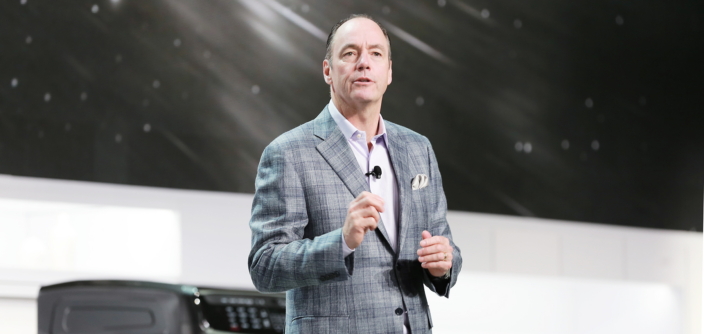[Interview] Discussing Samsung’s Approach to Smart Home Innovation with Family Hub 2.0
on January 18, 2017
Yoon Lee, the Senior Vice President and Head of the Product Innovation Team and Head of Content and Services at Samsung Electronics America, is driven to create products that harness the power of IoT to offer users meaningful solutions.

At CES 2017, Samsung showcased its latest devices designed to deliver a peerless smart home experience, including its upgraded Family Hub refrigerators. Here, Lee discusses the development process that’s yielded Family Hub 2.0.
Q: First, how do you identify specific aspects of consumers’ lives to design new products and services around?
Yoon Lee: If you can identify a pain point and create a meaningful solution, then that’s a very good start.
Pain points come in two flavors: obvious and latent. Latent pain points come as a pleasant surprise – that feeling of, ‘Oh, I never knew I had this pain point until I used this product.’ Because consumers don’t know what they don’t know, it’s up to us, through mountains of data and behavioral research, to come up with hypotheses that will lead to insight.
A good example is backup cameras in cars. When they first came out, many saw them as a solution that few would care about. But now, the technology is in such a mature state and so integral, that if it were suddenly taken away, you’d feel extremely uncomfortable. With latent needs, you don’t really know they’re there until you have a solution, but once you have one, you don’t really want to go back.
Q: What are some of the key insights you gained when exploring modern consumers’ latent kitchen needs?
Yoon Lee: The role of the kitchen has changed dramatically over the last decade or two. In the past, it was a space where people prepared meals. Now, it’s where families congregate, manage their schedules, enjoy entertainment, socialize and eat. The kitchen has moved away from a food-centric role to more of a family command center.
You therefore don’t want to create a food product; you want to create a ‘kitchen product’. If you think about what a kitchen product is, there are three pillars: in the kitchen, people have food, family-related activities and fun. These are the areas Samsung wants to cater to for consumers and create meaningful solutions around.
Q: How does Family Hub’s design cater to food, family and fun?
Yoon Lee: In the past, if you looked at food, family and fun in the kitchen, there were lots of ad-hoc solutions. ‘Family’ could be magnets and Post-its on your refrigerator, a tablet, or a computer in your kitchen, while ‘fun’ could be a kitchen TV.
Samsung was looking for a seamless platform to shape the kitchen’s role in a meaningful way, and the refrigerator was a natural choice. After all, if there’s one device in your home where if it gets turned off, you’re devastated, it’s the refrigerator. There isn’t a better platform for managing your lifestyle in the kitchen.
To best manage your ‘connected’ lifestyle, you also need an interface that can handle physical and virtual activities, and a touch-based screen easily accommodates that. So these were key insights that helped Samsung develop a refrigerator that could serve as a modern ‘kitchen device’.

Q: How has Family Hub 2.0 been enhanced to create a better kitchen experience?
Yoon Lee: One important aspect of Family Hub 2.0 is that it’s changed from a hardware platform to a software platform, which means it’s expandable, adaptable, and caters to evolution.
This means the solutions Samsung is offering around food, family and fun can get better over time; the product can become more relevant to your lifestyle; Samsung will be able to incorporate more partnerships; and the solutions can become more elegant.
Family Hub 2.0 offers more flexibility and functionality to help consumers better manage their lives and their household products. And for an even more convenient kitchen experience, Samsung’s advanced voice technology has also been integrated across Family Hub 2.0’s apps.
Q: What are some applications you could see in Family Hub’s future that could further streamline users’ ‘connected’ lifestyles?
Yoon Lee: I’d like to see smart homes become part of the Family Hub solution, so users can control appliances, smart things and IoT solutions throughout their home from their Family Hub refrigerator.
For instance, now, if you’re in the kitchen and the doorbell rings, with a ‘connected’ doorbell, you have to pull out your phone to see who’s there. Instead of that, let’s say while you’re cooking the image shows up on your refrigerator.
If you have a baby monitor and your baby starts crying, the current solution is, again, to pull out your phone or a separate baby monitor. If the image popped up on your Family Hub refrigerator, that would be another elegant solution. So there are many meaningful use cases where this kind of connected technology could play a big role in the future.





